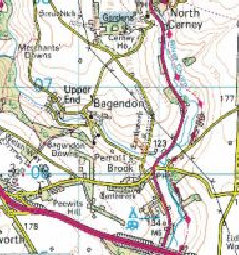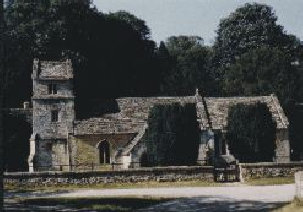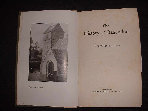The “History of Bagendon” was published by George Edward Rees in 1932. Rees was rector of the church and lived in the hamlet a different times from the 1880's to 1930's . He saw Bagendon as a part of the British nation in his detailed remembrances. Much of what follows comes from his work.
It’s history is ancient. Roman artifacts have been dug from the churchyard. It’s location attests to it’s being part of the Dobunni
community. As a Christian settlement it predates 680 AD when it became part of the Bishop of Worcester’s See. These folk were likely
Romano British. The church was built below the level of the adjacent creek on low land that regularly flooded. This oddity plus the
discovery of Roman artifacts on the site indicate it might have been a Roman worship spot prior to a building being erected.. The
local Saxon settlers likely worshiped at the far end of the parish, around Woodmancote where their gods included Thor and Woden.
In general the settlers were a group of free neighbors who engaged in agriculture. Land tillage was by lot on a temporary basis and in common they shared a team of oxen, Meadow land was held in common. Winter and spring grain, beans and a long fallow was the usual rotation. Land was set in long strips for tillage but over half was untilled and unfenced. Everone was entitled to get wood, and feed swine on acorns and other nuts. The Saxon land strips existed until the enclosure act of 1792. A map of this exists including the field names.
At Bagendon there was a mill, Trinity Mill, for hundreds of years. It is now in an outdoor museum. Bagendon was held after William the Conqueror by Hugh Lanse(Donkey). Gilbert of Thorold held North Cerney, Rendcombe and other places. The other adjacent land owner, Roger de Lacy, joined with them taking sides with Robert of Normandy who was unsuccessfully challenging to become William’s successor. As a result they lost their lands in 1088 to Robert Fitzhamon, Earl of Gloucester who got North Cerney. (the word Cerney may be derived from Saxon CERNE which means stone.) it remained in their hands for centuries.
Bagendon was taken from Hugo L'Anse, same reason, and given to the Chandos family. The Sublease for Bagendon eventually went to the DeBagendon ‘s from about 1100 until 1382. The Chandos were fighting knights and kept a fortified castle, first at Hereford and later Sudeley.
The Chandos held land mostly on the welch border (13 manors there) and had obligations in Scotland and France. Thus they were often in battle and demanded the services of their knights. This meant that the free men of Bagendon would have been forced often to report to duty. At this time the population of the parish numbered around 60 persons. Richard de Bagendon in 1254 was at the siege of Hereford Castle defending the Chandos family. Sir John Chandos, Captain, helped sail the army to fight at Agincourt. The Chandos line produced mostly daughters who married into the Brydges and Berkeley families.(during the wars of the Commonwealth Cromwell’s Roundheads destroyed the tombs of the Chandos family.)
Again the de Bagendon family lost control of other manors they held after the battle of Evesham in 1265, where parliament attempted to check the king’s rule. Later in 1286, 16 years after the battle Richard’s son also Richard had to pay the debts of his ancestor, a sum of 2 marks per year. This debt was to be passed onto yet another descendent ,Richard de Bagendon. Richard decided to become a priest. This broke the chain of debts. However in 1304 Richard was suspended for fathering William de Bagendon, a bastard. He was suspended for 6 months for not owning up to the fact when he became a priest. In 1318 Richard already his father’s chaplain became Rector of Bagendon. At this time there had been a cattle raid from the next valley and Richard rounded up his parishioners and led them into a raid to steal cattle from the Duntisbourne people and burned down their rectors house. Richard sold the stolen cattle at the Lechlade market. The buyers got into trouble when it was found out and Richard went to trial he paid a fine and since he was priest was let out of jail. He continued on as priest for many years, survived the Black Death, and died after 1354. He was the last of the de Bagendon knights. After him the manor was transferred to the wealthy Company of Weavers in 1382. King Richard gave it to the Cirencester Weavers Guild who placed the church in the hands of Holy Trinity Church at Cirencester where it remained for some time. This action also removed the feudal obligations of military service of the residents to go to fight the wars of the Chandos family.
Nov 18, 1382 at petition of Richard Playn et al for 40 marks a licence was granted to found a chantry for 2 chaplains at Cirencester. Richard was acting on behalf of the Weavers Company. This was part of the action of the weavers to escape the control of the Abbott by the woolmen and weavers. In the 1400's Bagendon Church like North Cerney and Cirencester was rebuilt with the money from the wool business. The weaver’s company was closely controlled and their daughters married into each others families.
In 1349 the plague killed many people and times were bad. There were no vegetables in the winter, salt became too expensive for the meat, there was no money, pay became in food.
Bagendon Church, known as St. Margaret was for over 150 years affiliated with St. Mary’s in Cirencester. It was uncertain if the church was dedicated to St. Margaret of Antioch or the Queen of Scotland, Margaret who died in 1093 and canonized in 1250 about the time the church was built.
Moorwood about 1440 was held by William of Nottingham.
Thomas Seymour, brother- in-law of Henry VIII, lived at Sudeley Castle and was lord of Bagendon. His niece Elizabeth (ER I) stayed
with him as a princess age 15. She returned as queen to visit in 1592. Thomas was beheaded in 1549 and the Marquess of Bath, John
Thynne acquired the land. He also got the church land after the dissolution. Thynne lived at Longleat where he built that manor (1611)
and also Woodmancote. His son John succeeded him in 1580. His daughter married the Lord Mayor of London Rowland Hayward. The Thynnes
had sufficient power to influence elections for seats in parliament.
The parish register for Bagendon dates back to 1630 and the leading families were Eycotts of the Moor (Woodmancote) and the Bowles of Bagendon. They were referred to as Mr. and Mrs. being thus small gentry.
In the 1740's William Pitt (prime minister) was lord of Bagendon and his son after. In 1792 with the enclosure act the half of the land of Bagendon that was common pasture land became enclosed for cultivation. This was the first change since Domesday. The manor rights were sold by Thynne to Pitt. The church was given to Jesus College, Oxford. The last rector appointed by the Thynnes was Rev. John Bythesea of Wick House in Wiltshire. Moorwood at Wooodmancote went to Squire Haines.
“History of Bagendon”
In this book the following references are made to the Eacott - Eycott family. The record of information ends with 1880.
Introduction: Bagendon is a parish 3 miles long and up to 2/3 of a mile wide. It has ancient earthworks from pre Roman times; an ancient
inn at the crossroads with a gibbet and a record of a political duel; there is a Norman church; a woods dating back to king John.
The parish had once been featured in an early act of Parliament. Some famous people were connected with Bagendon including a queen's
husband and a royal gaoler.
Moorwood is an old demesne adjacent to Woodmancote. Bagendon manor house was known as the mansion. It was built by a member of the Thynne family who also owned Longleat. The Haines family refaced it in a Georgian style.
The Moor was another residence owned by another Haines at the same time. The house in 1980's was occupied by captain Robinson.
At Domesday there were about a dozen households (60 persons) and in 1712 there were 13 houses and about 60 people. And as at Domesday about half the land was cultivated.
The first bishop of Worcester was appointed by 680 AD and his land included Bagendon. Before the Norman conquest the land was held by a thane called Ulward. Under this lord were five yeomen and five serfs. The land was divided equally into occupied and unoccupied property and held equally by the lord and the yeomen (churls). This arrangement lasted until the enclosure act of 1792.
At Domesday Hugo L'anse (Hugh Donkey) succeeded Ulward (Woolward). Gilbert from Hugo held Bagendon, North Cerney, and Rendcomb but not Eycot. In 1087, Hugo and Gilbert took sides with Robert of Normandy against king William. In 1088 William gave their lands to others. Robert Fitzhamon got North Cerney and for centuries it belonged to the Earls of Gloucester. Bagendon was given to the Chandos family (Sudeley Castle) who lost it during the time of Henry VIII. The de Bagendons were subifudators (subleased) from the Chandos. Later the king gave the land to the company of weavers of Cirencester who in turn gave it to the priests of Cirencester about 1382. On November 18, 1382 the transfer of land was entered as an Act of Parliament at Westminster. The property in later times, after 1450 was owned by some of these families; Twynyho, Prelatte, Arnold, Tame, Nottingham and Morton. Some of these were transfer by marriage. Sir William of Nottingham held Moorwood and Woodmancote in the 1440's.
[Pg 59 reference] "In the north east corner of Bagendon church yard near the Norman Coped slab is a massive flat stone that once rested
over Frances Ashmeads body on the north side of the church, the only interment there. She married John Ashmead Jr. and lived at the
Bear (Inn). Becoming a widow she went to live at the Moor where children were born to her and Mr. Eycott. She died in 1776 and the
"cockley" stone upon her grave is like that still quarried at Moorwood and Beech Pike. Tradition calls her Madam Ashmead and her burial
all alone in the cold shadow of the church is in contrast to ...."
Sir John Thynne added to the two manor houses and rebuilt them as mansions after 1792. The patronage of the Thynnes was mostly to Wiltshire men. They appointed the priests from as far away as Wooton Bassett. The Tynnes owned Longleat, and via the Seymours were involved with Elizabethan royalty.
[Pg 78] "The old parchment registers (1630-1740) show how few labourers were hired; the names are chiefly of those who held the small
tenements or the demesne lands. The demesne houses at Bagendon and Moorwood were occupied by small gentry and yeomen; in the early
days the name Eycott belonged to Moorwood and Dowle to Bagendon; these names appear for many years in the records........
For ten years before 1660 there were three rectors, the last appointed by Cromwell, who were Puritans. There is not a single entry
to show these men baptized, married or buried anyone. But from then on the strength of the Puritan names is shown Job, Erasmus, Lydia,
Jesse, Abigail, Rebecca, Abraham, Emmanuel. In these
registers the designations of the chief inhabitants were Mr. and Mistress, kept for the Dowles and the Eycotts except for Madam Frances
Ashmead, but her title was equivocal. The farmer is called a husbandman, and there were a cordwinder, a rough mason, and two clothyers,
a daylabourer and a shepherd, an almsman and an almswoman, a poor batchelor and an ancient maid besides several parish clerks."
Other records include churchwardens book from 1776. At Jesus College, Oxford is a map of Bagendon. (an ordinance reproduction has been made). There is a reference in the Hockaday manuscript - an index of Gloucester parish registers, deed and enclosure awards of 1792 and the Bagendon enclosure award of 1792.
" Three parishes meet at the corner of Moorwood and at that point there is a no man's land not included in any of them. This curious
fact is not an accident. There is an old Saxon custom of leaving some land for the sylvan gods."
Moorwood was bought by Nathaniel Haines son John about 1800. He enlarged the house and lived there. At the same time his uncle Edward redid the manor house. There are curious external resemblances between them.
In 1572 Thomas Eycott was one of the churchwardens. There were but 7 households so a sermon was given only once each quarter. There was no cup for the service only a chalice.
In 1713 William Huntington M.A. became the curate and before his induction Berkeley Eycott and William Chandler were sequestrators. In 1714 an attempt was made to exchange five acres of Berkeley Eycotts land in North Field with some church land held for the benefit of the repair of the ancient mill. Nothing was done until 1792.
Thomas Eycott, yeoman, of Bagendon his wife Mary and children Thomas Jr, Elizabeth, Rebecca, Mary reputed to be papists, took the oath of Allegiance to king George in 1715. Thereafter Thomas Eycott was appointed constable of Badgington (sic). This meant he was the primary government official for the parish and thus was sworn not to be a catholic which would have denied him any government position.
[pg 164] Place Names
The Moor - the old name of the house now called Moorwood.
Usually the abode of men of substance, Eycott, Agg, Small, Haines, Longworth, Robinson.
Moorwood - the most ancient wood mentioned in King John's reign and the last property disposed of by the Marquis of Bath.
North Field - an extensive waste on the north before the enclosure act.
Parson's Grove - given out of Moorwood for repair of the mill. When the monks left the parson got control.
Egg's Piece - belonged to Agg or Egg of North Cerney and had connections with the Vyner family.
Great Wood Piece - Moorwood.
The church book of 1778 shows no Eycotts renting seats.
Testators of Bagendon - from 1427 to 1500 the names were Nottingham, Turner, Prelatte, Tywnho, Tame
In 1525 the will of Thomas Foxley was witnessed by Syr Lawrence Warburton, Wyllyam Eycott and Haylyn Bradeley.
1500 -1600 Haines, Tame, Hobbes,
1581 Richard Eycott of North Cerney will,
1583 Thomas Ekott will,
1629 Robert Eacott will,
1717 Berkeley Eycott will,
1730 Thomas Eycott will,
1732 Thomas Eycott will, and other persons.
BAGENDON






Photos of Bagendon Church





